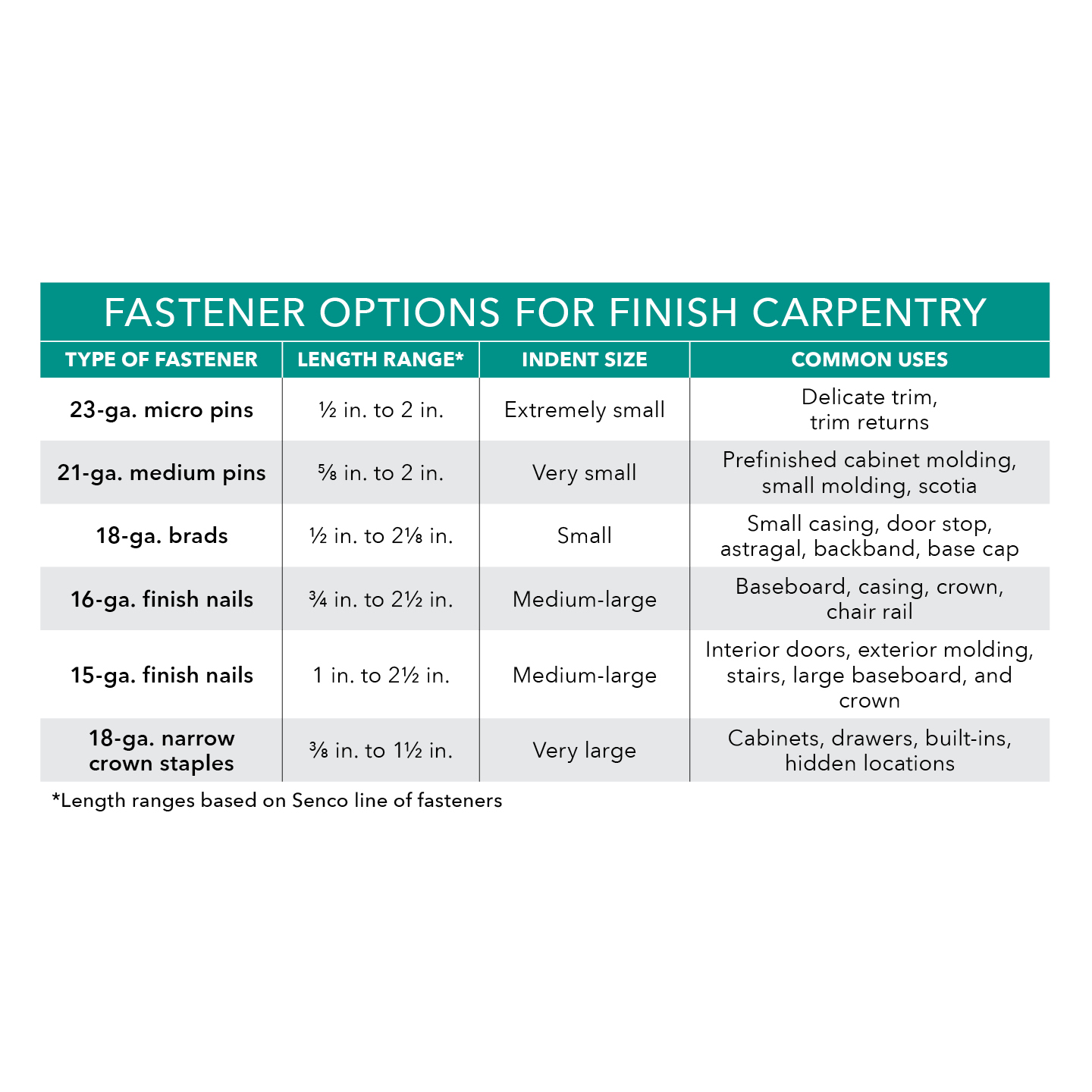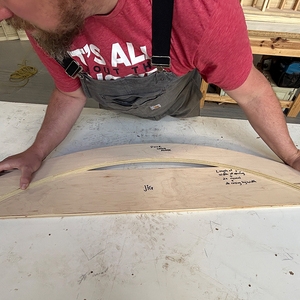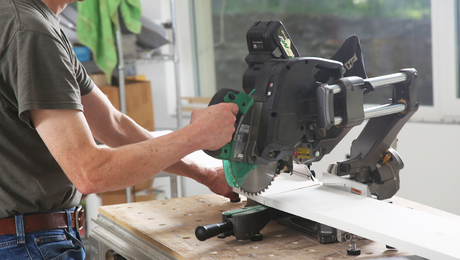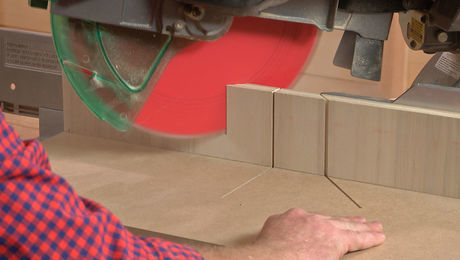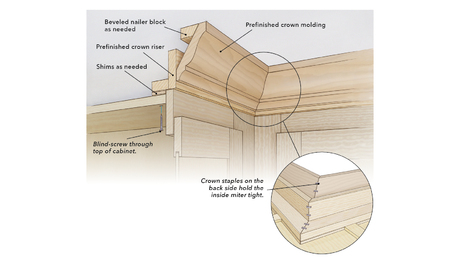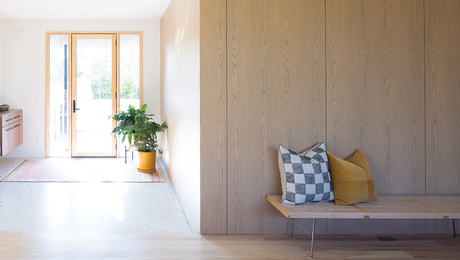Floating Shelves Made Strong and Simple
These grain-matched, mitered floating shelves slide onto a cleat for easy installation and a clean, modern look.
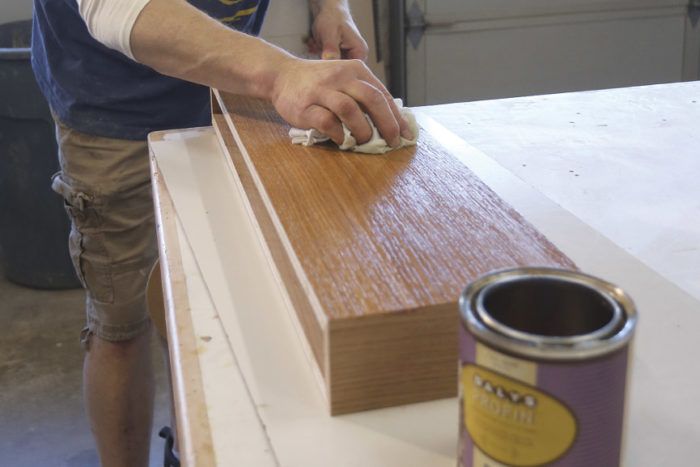
Synopsis: Floating shelves have a modern, seamless look. This article explains how to create floating shelves from 3/4-in. rift-sawn white-oak plywood, from cutting the mitered corners, to glue up, to installation. The author puts extra emphasis on the finishing touches—wire brushing, light sanding, and touch-ups.
You don’t always need to gut a kitchen to give it a new look and better function. We recently completed a partial-kitchen remodel in which we removed some cabinets, modified some cabinets to upgrade their appearance and purpose, and added some new cabinets to match the originals. We painted everything, and installed new countertops, a new backsplash, and a new range hood. And to give the kitchen the modern look the homeowners were after, we built and installed four floating shelves.
The seamless look of floating shelves
These floating shelves are made from 3⁄4-in. rift-sawn white-oak plywood. This grain-matched look is popular right now and it’s a particularly interesting detail to me as a carpenter, because I think a lot about wood grain—in terms of how to best use it both for the performance of what I’m building, and for the best looks. Because these floating shelves are made from veneered plywood, I don’t have to worry about seasonal wood movement. In fact, the grain is purely aesthetic. Though the shelves appear as one big piece of white oak, there is no end grain. Instead, the grain is continuous, wrapping from the front of the shelf around each side. The grain also continues from the front of the shelf to the top and bottom. So the look doesn’t actually mimic a solid board, but the shelves have a superclean, seamless appearance.
This seamless effect is achieved by laying out the front, sides, top, and bottom of each shelf next to each other on the plywood and making as few cuts as possible, thereby losing as little material as possible to sawkerfs.
Cut precise parts
The first thing I do is rip the full sheet of plywood down to just what I need for each of the floating shelves. Then I lay out the parts show-side up and mark them to make it easy to remember how they’ll go together. I also leave everything laid out on the table as I cut the parts. I square-cut all the parts first, then cut the angles on all of the edges. This two-step process ensures that I’m not losing any more grain when I cut the angled edges. The only material removed by the miter saw (for the 45° crosscuts) and tablesaw (for the 45° rip cuts) is from the core of the plywood, not the veneer.
Because of the way I later fold these parts back together to glue up the shelves, accurate dimensions are crucial. Each shelf’s top, bottom, and front must be exactly the same length; the top and bottom must be exactly the same width; and the length of the sides must precisely match the width of the top and bottom. Any error and the joints won’t be tight. To have enough contact for strong glue joints, the miters can’t be much more than 45°, but you can back-cut by an extra degree or two to make sure the front of the joints come together without a visible seam.
Clean cuts on the miter saw and tablesaw require good technique and sharp, high-quality blades. Make sure you have both before you try to build floating shelves like these.
The right grain for tight miters
These shelves have a particularly modern look, with the grain wrapping from the front of the shelf to the top, bottom, and sides. The right plywood is one of the keys to getting this effect. The tight and straight grain of the rift-sawn white-oak plywood used here is a perfect choice. To ensure a good grain match as the veneer wraps around the shelf, the parts are laid out next to each other on one section of the plywood.
Go easy on the sanding
To glue up the shelves, I lay all the parts out flat on a table with the angled edges facing down, and then connect all the joints with clear packing tape. Other tapes will work, but clear packing tape is strong enough to hold the parts together and I can see the joints and make sure everything comes together tightly during glue up, which is a matter of folding the parts together, adding a bit more tape, and clamping.
Sanding veneered plywood can be risky. A light touch before finishing is okay, but on shelves like these, you need to be careful at the miters. It’s very easy to sand through the veneer. So, instead of using sandpaper to remove glue squeeze-out, use a card scraper. While I sanded these shelves very little, I did do some things to get them ready for finish.
First, I wire-brushed the plywood. The effect is subtle, but it adds depth and texture to the grain when finished. I also gently rolled the edges with a screwdriver shaft. This turns the veneer down, closing any small gaps at the miter joints, and reduces the risk of sanding off the veneer and exposing the core below. Then, I very lightly sanded the edges. Where there was a small gap, I touched it up with a paint pen to match the color of the veneer. For an accurate color match, I wet the plywood to mimic the clear poly I was planning to finish the shelves with before choosing a color for the touch-up pen. After blowing the shelves clean with compressed air, I finished them with wipe-on poly, one coat a day for three days.
Don’t overthink the install
There are lots of ways to install floating shelves, but I don’t think it needs to be too complicated. I slipped these onto cleats made of three pieces of 3⁄4-in. plywood, glued and screwed together. Because we had opened the wall where the shelves are installed, I was able to put blocking where I needed it, but it would be perfectly fine to screw the cleats to studs if the layout works. I screwed the cleats to the blocking with TimberLok screws.
For a clean look, I made the shelves to match the height of the subway tile and worked with the tile installer to align the shelves with the tile courses. The cleat matches the inside dimension of the hollow shelves, so the fit is very tight. All I did was add a little glue inside the shelves before slipping them onto the cleat. I have no doubt that these shelves will hold anything that the homeowners choose to put on them.
I recently returned to the kitchen, and these floating shelves are holding up great. I’m always looking for ways to make my methods and finished work better, and sometimes the best way to learn is to revisit projects and build things a second time. I was able to revisit this project, and found that there’s no need to change a thing. This process works and these shelves look awesome.
For further reading on this topic, check out these links:
For details and many more photos in this article, please click the View PDF button below.



